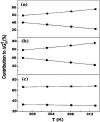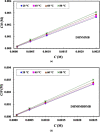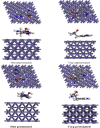A Review on Interactions between Amino Acids and Surfactants as Well as Their Impact on Corrosion Inhibition
- PMID: 36591120
- PMCID: PMC9798777
- DOI: 10.1021/acsomega.2c03629
A Review on Interactions between Amino Acids and Surfactants as Well as Their Impact on Corrosion Inhibition
Abstract
Amino acid-surfactant interactions are central to numerous studies because of their increased effectiveness in chemical, biological, household and industrial use. This review will focus on the impact and effect of the physicochemical properties, temperature, pH, and surfactant chain length of the amino acid for detailed exploration of amino acids and surfactants in aqueous medium. The impact of cosolvent on self-aggregation, critical micelle concentration (CMC), and binding affinity with other biomolecules, as well as amino acid-surfactant interactions, are the epicenters. The results show that increasing the temperature causes negative enthalpy for ionic surfactants and micellization, implying that micellization and amino acids are thermodynamically spontaneous and exothermic, accompanied by positive entropy. As these physicochemical studies are additive, the amino acid and ionic surfactant interactions provide clues on protein unfolding and denaturation under different media, which further changes with a change in physiological conditions like pH, cosolvent, chain length, and temperature. On varying the pH, the net charge of the amino acid also changes and, subsequently, the binding efficiency of the amino acids to the surfactants. The presence of cosolvent causes a lowering in the hydrophobic chain, which changes the surfactant's CMC. At a reduced CMC, the hydrophobic characteristic of amino acid-surfactant associations is amplified, leading to rapid denaturation of proteins that act as propulsion under the influence of extended chain surfactants. Amino acids are one of the most intriguing classes of chemicals that produce high inhibitory efficacy. Amino acids are also a component of proteins and therefore, found in a significant part of the human body, further making them a promising candidate as corrosion inhibitors. In this review article, authors have also focused on the collection and investigation for application of amino acid-surfactant interactions in corrosion inhibition. Various predictive studies/in silico studies are also reported by many research groups, such as density functional theory (DFT) calculations and molecular dynamics simulations to obtain tentative electronic, structural, and physiochemical characteristics like energies of the highest occupied molecular orbitals and lowest unoccupied molecular orbitals, binding energy, Gibb's free energy, electronegativity, polarizability, and entropy. In silico studies are helpful for the mechanism predictions of the process occurring on metal surfaces.
© 2022 The Authors. Published by American Chemical Society.
Conflict of interest statement
The authors declare no competing financial interest.
Figures



















References
-
- Grace A. C.; Daniel O. U. Micellization of a Cationic Surfactant in Mixed Aqueous and Non-Aqueous Solvent Systems. J. Appl. Sci. Environ. Manag. 2016, 19 (4), 577.10.4314/jasem.v19i4.2. - DOI
-
- Fuguet E.; Ràfols C.; Rosés M.; Bosch E. Critical Micelle Concentration of Surfactants in Aqueous Buffered and Unbuffered Systems. Anal. Chim. Acta 2005, 548 (1–2), 95–100. 10.1016/j.aca.2005.05.069. - DOI
-
- Cheng C.; Huang Z.; Zhang R.; Zhou J.; Liu Z.; Zhong H.; Wang H.; Kang Z.; He G.; Yu X.; Ren Z.; Qiu T.; Hu Y.; Fu W. Synthesis of an Emerging Morpholine-Typed Gemini Surfactant and Its Application in Reverse Flotation Carnallite Ore for Production of Potash Fertilizer at Low Temperature. J. Clean. Prod. 2020, 261, 121121.10.1016/j.jclepro.2020.121121. - DOI
-
- Yu L.; Lu T.; Luan Y.; Liu J.; Xu G. Studies on the Effects of Amino Acids on Micellization of CTAB via Surface Tension Measurements. 2005, 258, 375–379. 10.1016/j.colsurfa.2004.10.066. - DOI
-
- Pinheiro L.; Faustino C.. Amino Acid-Based Surfactants for Biomedical Applications. Application and Characterization of Surfactants; InTech, 2017; 10.5772/67977. - DOI
Publication types
LinkOut - more resources
Full Text Sources
Research Materials
